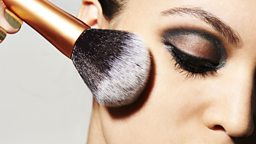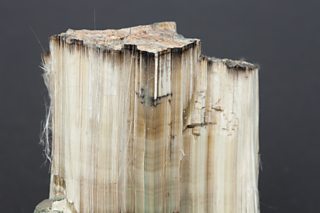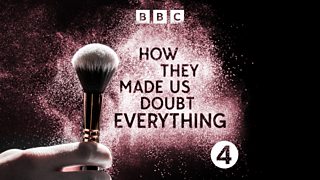Is there asbestos in make-up?
After being diagnosed with an incurable cancer, Hannah Fletcher wants consumers to be aware of the risk of asbestos contamination in blushers, face powders and body powders that contain talc.
When her cancer tissue was examined, a pathologist concluded Hannah Fletcher’s cancer was caused by exposure to asbestos in her talc-based cosmetics. In Βι¶ΉΤΌΕΔ Radio 4’s How They Made us Doubt Everything: Talc Tales, Hannah Fletcher explains the impact her cancer diagnosis has had on her life and her decision to sue the companies that made her favourite cosmetics.

"As a child my brother and I were a little bit naughty. We used to have talc battles and cover each other in what looked like snow." Hannah Fletcher fondly recalls playing in clouds of talcum powder when she was young. As she grew up she would wear the same expensive brand of face powder and blusher as she had sensitive skin. She never thought that something that made her feel pretty might have led to her contracting cancer.

One of the worst things that I've had to do, was write letters to my children in case I died.Hannah Fletcher
When she reached her early forties, now with two young children of her own, Hannah was diagnosed with a rare cancer called mesothelioma. This type of cancer is almost exclusively caused by exposure to asbestos, according to the UK government’s Health and Safety Executive. As part of her treatment she underwent a risky 14 hour operation which was difficult to prepare for:
"One of the worst things that I've had to do, was write letters to my children in case I died. That was horrific; trying to explain to a child what might have happened."
Testing make-up for asbestos
Given the concern about what may have caused Hannah's cancer Βι¶ΉΤΌΕΔ journalist Phoebe Keane sent eight make-up products to be tested for asbestos. She checked what she had in her own make up bag that contained talc, then bought brand new versions from the high street, with the factory seal intact. She sent them to Brunel University’s Experimental Techniques Centre for testing. Using the most sensitive microscope, in two of the samples Brunel’s scientists found one asbestos fibre in each. Brunel University’s lab says they need to find at least three fibres to confirm the asbestos fibre came from the make-up, despite having strict protocols to ensure their lab was not the source of the contamination.
This isn’t the first test of this kind. Back in 2021, the UK government’s Office for Product Safety and Standards ordered tests of 60 low-cost eye shadows and face powders and 24 "child-appealing" make-up products. In one child-appealing product, they found one asbestos fibre and in two of the low-cost samples, they found five and three asbestos fibres.

Asbestos and talc are both naturally occurring minerals
So how could asbestos, a known carcinogen and banned substance, find its way into make-up? Asbestos is a commercial name for something that can be formed from six naturally occurring minerals. Talc is also a mineral and is often found with asbestos minerals in the ground. They are both formed under similar conditions and they’re both made of the same chemical elements. So if you have talc in the earth, you could also have asbestos too.

Even though some companies have thorough testing methods, because of their close association in nature, Ashley Howkins, Lead Scientific Officer at Brunel University’s lab, says there’s no way of completely eliminating the risk of asbestos contamination in talc.
Talc on trial
The issue was highlighted by a court case launched in the USA in 2018 by 22 women who alleged that Johnson & Johnson’s talc products caused them to develop ovarian cancer. A jury found that Johnson & Johnson’s talcum powder products contained asbestos and that the company had failed adequately to warn users of the risk of harm posed by the asbestos. The jury found this failure caused or directly contributed to the death, or the cancers affecting, 22 women. The company was eventually ordered to pay $2 billion in punitive damages, or £1.5 billion. It’s one of the biggest pharmaceutical payouts of all time.
Some other juries have found in Johnson & Johnson’s favour. One jury in Florida found that Johnson & Johnson was not liable for damages relating to a woman’s cancer. The company has successfully appealed or won more than a dozen other cases. The company stopped using talc as an ingredient in its Baby Powder in 2023. They still maintain the product was safe and say sales were declining due to "misinformation around the safety of the product, and a constant barrage of litigation advertising".
Are there any health risks?
But if there are only trace amounts of asbestos fibres in a cosmetics product, does this pose a health risk? Dr. Astero Klampatsa, mesothelioma and lung cancer immunologist at the Institute of Cancer Research in London says we don’t know how many asbestos fibres it takes to cause cancer. "Cases have occurred even with brief or low level exposures to asbestos. The only real way to say that we are in a safe level, is if we have no asbestos exposure at all."
"So using a beauty product that might contain one fibre of asbestos, poses minimal risk. If we say that one uses this product over time continuously, then this risk increases, because it's additive. However, even with these multiple uses, the overall risk remains very, very low. Saying all that I would advise avoiding any unnecessary exposure. I would personally choose a talc-free product."
Today, some cosmetics companies are moving away from using talc. But it’s no comfort for Hannah Fletcher, whose cancer has now spread and can’t be treated. "‘It just felt like all of this trauma and this horrific impact on our lives had been so unnecessary. I’m really angry, because my life has been devastated."
Details of help and support is available at bbc.co.uk/actionline
To hear more, listen to How They Made Us Doubt Everything: Talc Tales on Βι¶ΉΤΌΕΔ Sounds

More from Βι¶ΉΤΌΕΔ Radio 4
-
![]()
Do cholesterol-lowering drinks and spreads actually work?
Greg Foot is dipping into cholesterol-lowering foods, drinks and medications to figure out which products really work.
-
![]()
Jon Holmes Says the C-Word
In Jon Holmes Says The C-Word, Jon will be wearing his heart - and, quite frankly, all of his body parts - on his sleeve.
-
![]()
Are fish memories really as bad as we think they are?
Do goldfish, or other fish for that matter, really have bad memories? And how well do our own memories stand up under scrutiny?
-
![]()
Five ways to unwind and find Deep Calm
Here are my five ways to find inner stillness and calm…





